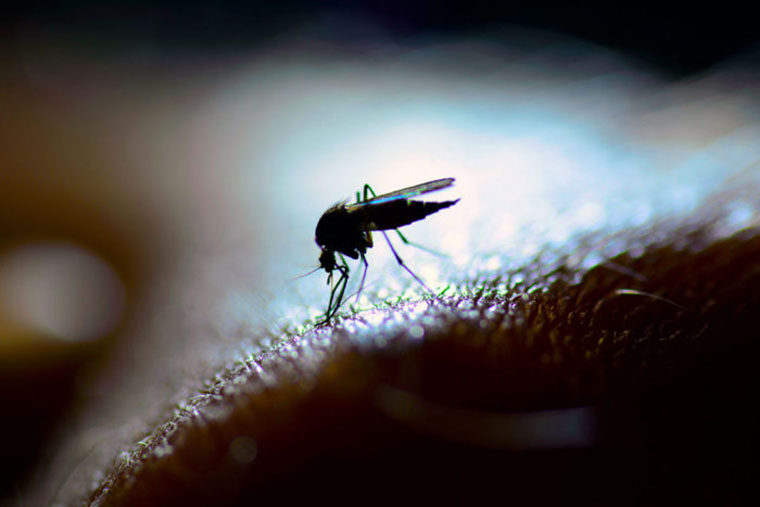Sebastian Nasamu, an MD/PhD student at Washington University School of Medicine in St. Louis, battled successive bouts of malaria as a child growing up in Ghana. He survived – but decided long ago to commit himself to eradicating the disease. The possibility that his work could lead to a treatment is the reason he goes to the lab every day.
The pursuit has led the School of Medicine’s Nasamu, Daniel Goldberg, MD, PhD, and colleagues to the identification of two crucial enzymes in the malaria parasite’s arsenal: One helps the microbe invade red blood cells; the other aids the parasite’s escape from the cells so it can move on to infect other cells.
Further, the researchers showed that a drug that cures malaria in mice works via one of these enzymes. The findings – published Oct. 27 in the journal Science – suggest that targeting such enzymes could lead to new kinds of anti-malarial drugs, which are urgently needed as resistance to current drugs continues to spread.
“We identified enzymes that appear to be central for invading and bursting out of red blood cells, and showed that they are targets of anti-malarial inhibitors,” said senior author Goldberg, the David M. and Paula L. Kipnis Distinguished Professor of Medicine.
An estimated 212 million people contracted malaria in 2015, and more than 400,000 – mostly children under age 5 – died of it. The disease is spread by the bite of a blood-sucking mosquito. Parasites in the mosquito’s saliva slip into a person’s bloodstream and destroy red blood cells.
“When I was growing up I had malaria maybe 30 times, two or three times a year,” recalled Nasamu, the study’s first author. “You get sick, your mom goes to the drug store, buys a couple of pills, you take them. With luck, within three days you’re feeling better, and within a week you’re back up and can go to school.”
As a child, Nasamu probably was treated with chloroquine. Today, so many malaria parasites are resistant to chloroquine that the drug is no longer useful in Africa. Instead, the drug of choice is artemisinin.
“There is a massive international effort to develop new anti-malarials, but all the top prospects are based on artemisinin, and now resistance to artemisinin is spreading,” said Goldberg, who is also a professor of molecular microbiology. “If artemisinin fails, there’s not much else in the pipeline.”
In an effort to find new drugs to battle the deadly disease, Goldberg, Nasamu and colleagues have been working their way through a group of 10 parasite enzymes known as plasmepsins, trying to find the ones the parasite relies on to cause disease.
They finally hit pay dirt with plasmepsins IX and X. By inactivating the genes for the two enzymes, they found that the enzymes are indispensable in getting the parasites into and out of red blood cells.
 SVETLANA GLUSHAKOVA
SVETLANA GLUSHAKOVA SVETLANA GLUSHAKOVA
SVETLANA GLUSHAKOVAThe parasites without plasmepsin X were able to invade red blood cells and multiply inside them, but then found themselves trapped. The parasites that lacked plasmepsin IX had the opposite problem: They burst out from red blood cells but were unable to penetrate the next round of cells.
These were the enzymes the researchers had been looking for. Invading and exiting red blood cells are crucial steps in the life cycle of the malaria parasite. A drug that blocks this step would stop the parasite in its tracks.
Goldberg, Nasamu and colleagues screened compounds known to work on enzymes similar to plasmepsins in search of ones that could inhibit plasmepsin IX or X. They found three that prevent the parasite from multiplying, including one that cured malaria in mice. These compounds had been developed by the Center for World Health and Medicine at Saint Louis University. But nobody knew which enzymes the compounds targeted.
The researchers exposed malaria parasites to each compound and then allowed the microbes to infect red blood cells. Parasites treated with the compounds behaved just like parasites that lacked plasmepsin X: They wriggled impotently inside red blood cells, unable to get out. Further experiments confirmed that the three compounds target plasmepsin X.
Even though one of the compounds has proven effective in mice, developing it as a potential anti-malarial drug for people probably will require some tweaking to its chemical structure to maximize safety and effectiveness. But knowing that it targets plasmepsin X should speed that process up considerably, the researchers said.
“If you don’t know what the target is and you’re trying to make a better drug, all you can do is try changing the molecule bit by bit, randomly, and hope it works,” Goldberg said. “If you know what the target is, and you know how the compound interacts with the enzyme, you can do a much smarter job of choosing chemical modifications.”
This compound is particularly appealing because parasites seem to have difficulty acquiring resistance to it.
“People have tried to induce resistance to this compound in the laboratory, and no one has been able to do it,” Goldberg said. “That doesn’t mean it can’t happen, but it’s a good sign.”
That possibility drives Nasamu.
“I would like to be able to contribute to the eradication of this disease because the people who suffer the most are the people I come from,” Nasamu said. “I easily could have died of this before I was 5. But instead, I am here.”
